List of Korean clothing
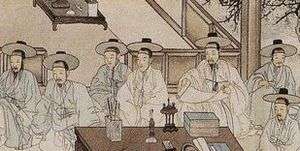 |
| Part of a series on the |
| Culture of Korea |
|---|
| History |
|
Music and performing arts |
|
|
Monuments |
|
National symbols of Korea |
|
This list is incomplete; you can help by expanding it.
Hanbok is a traditional clothing of Korea. This is a list of Korean clothing including the national costume, hanbok as well as headgear, footwear, and accessories.
Hanbok
| Baji | baggy pants (see more pictures at commons:Category:Baji) | |
| Chima | 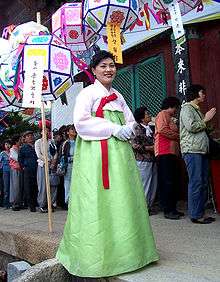 |
Chima is a type of skirt worn together with jeogori, short jacket. |
| Dangui |  |
Dangui is a female upper garment worn for ceremonial occasions during the Joseon Dynasty.[1] Dangui was also called dang-jeogori (당저고리), dang-jeoksam (당적삼), or dang-hansam (당한삼).[2] |
| Dopo | Dopo is a variety of po (an overcoat) mostly worn by male Confucian scholars called seonbi since the mid Joseon period. | |
| Durumagi | ||
| Garot | |
Garot is a type of working and everyday dress dyed with juice of unripe persimmons. It has been worn by Jeju Island locals. |
| Gwanbok | 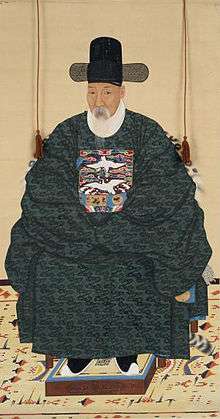 |
Gwanbok is a Korean general term referring to all business attires of government officers given by government, with Rank badge on them to distinguish hierarchies. |
| Hakchangui |  |
|
| Hwarot | 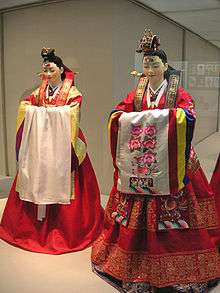 |
Hwarot is a type of traditional Korean clothing worn during the Goryeo and Joseon Dynasty by royal women for ceremonial occasions or by commoners for weddings.[3] It originated from the Kingdom of Khotan, Central Asia.[4] |
| Jeogori |  |
Jeogori is a basic upper garment which has been worn by both men and women. It covers arms and upper part of the wearer's body. |
| Jeonbok |  |
Jeonbok is a type of sleeveless long vest mostly worn by military personnel. It does not have overlapped column on the front side, and was worn over dongdari. |
| Jokki | vest | |
| Kkachi durumagi |  |
Kkachi durumagi is a children's colorful overcoat worn on Korean New Year. It was worn over a jeogori or jokki while the wearer could put a jeonbok over it. Kkachi durumagi was also worn along with headgear such as bokgeon, hogeon or gulle. |
| Magoja |  |
The magoja is a type of long jacket worn with hanbok, the traditional clothing of Korea, and is usually worn on top of the jeogori (short jacket). |
| Po | ||
| Sagyusam |  |
Sagyusam is a type of po (outer robe) worn by young boys until they had a coming-of-age ceremony called gwallye. The name was derived from the shape; the lower end of the garment is divided into four parts.[5] |
| Saekdongot |  |
Saekdongot is any hanbok patchworked with colorful stripes. It began to be made since the Goryeo period (918 – 1392). The name literally means "many colored clothing". It was usually worn by children of the age at one to seven year old. The saekdong can be applied throughout jeogori (short jacket with sash), majoja (buttoned jacket), durumagi (overcoat) or among others.[6][7] |
| Wonsam |  |
Wonsam is a female ceremonial topcoat during the Joseon Dynasty. The queen, princess consort, and consort to the first son of the crown prince wore it as a soryebok, a robe for small ceremonies, while wives of high officers and sanggung (court matrons) wore it as daeryebok, a robe for major ceremonies. The color and decorations of the garment around the chest, shoulders and back represent the wearer's rank.[8][9] |
Headgear
| Ayam |  |
An ayam is a traditional winter cap mostly worn by women during the Joseon period. It is also called aegeom meaning "covering a forehead". The ayam consists of a crown and trailing big ribbons. The upper part of the crown is finely quilted, and its outer fabric consists of black or purple silk. While black or dark brown fur is used for the rest of the crown. The fabric for the inner is red cotton flannel. A tassel attached to the upper center of both front and back. Some ayam worn by kisaeng (female entertainer) were luxuriously adorned with jewels. The ayam worn for spring and autumn has the same shape as the one for winter, but it is made of a lighter silk.[10][11] | |
| Banggeon |  |
Headgear | |
| Beonggeoji |  |
||
| Bokgeon |  |
||
| Chaek |  |
||
| Daesu |  |
||
| Gache | 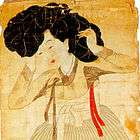 |
wig | |
| Gat | 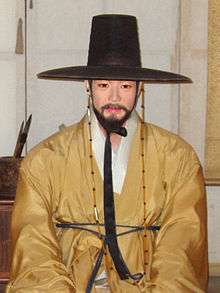 |
||
| Gulle | 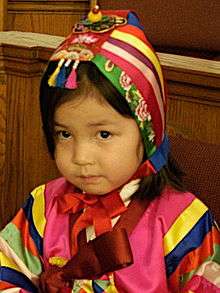 |
||
| Hogeon |  |
||
| Hwagwan |  |
Hwagwan is a type of Korean coronet worn by women traditionally for ceremonial occasions such as wedding. | |
| Ikseongwan | 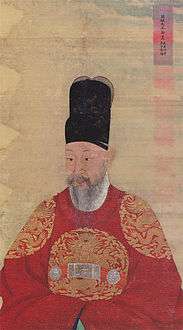 |
||
| Jangot | 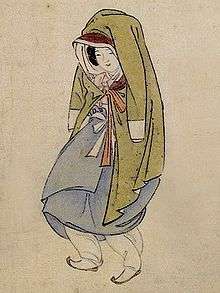 |
||
| Jeongjagwan |  |
||
| Jeonmo |  |
||
| Jobawi | |||
| Jokduri |  |
||
| Joujeolpung |  |
||
| Manggeon |  |
||
| Nambawi |  |
||
| Pungcha | 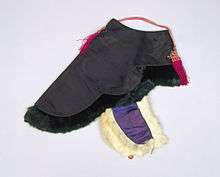 |
||
| Tanggeon |  |
||
| Tongcheongwan |  |
||
| Satgat |  | ||
| Sseugae chima | 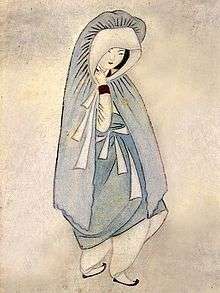 |
||
| Waryonggwan |  |
||
| Yanggwan | 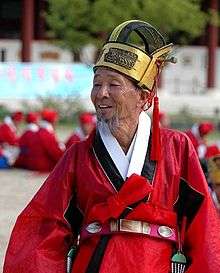 |
Yanggwan was a kind of crown worn by officials when they wore a jobok (朝服) and jebok (祭服, ceremonial clothing) during the Joseon Dynasty. |
Footwear
| Beoseon |  |
|
| Gomusin |  |
literally "rubber shoes". In present it is mostly worn by elder people and Buddhist monks and nuns |
| Hwa |  |
generic term referring to all kinds of boots |
| Hye (혜) |  |
Varieties: Buntuhye (분투혜), taesahye (태사혜), danghye (당혜), unhye (운혜) |
| Jipsin | ||
| Mituri (미투리) |  |
shoes made of hemp fabric |
| Mokhwa (목화) | a variety of hwa, worn by officials along with gwanbok (official clothing) during the mid and late Joseon Dynasty. | |
| Namaksin (나막신) | a type of wooden clog |
Accessories
| Baetssi |  |
hair ornament for young girls |
| Balhyang | pendant including incense image | |
| Binyeo (비녀) |  |
a large decorative stick like a hairpin |
| Buchae | Korean fan | |
| Cheopji (첩지 疊紙) | 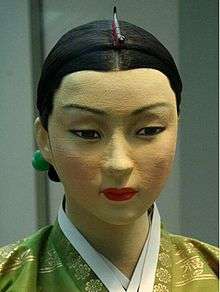 |
a hair pin |
| Chimnang (침낭) | pockets for needlesimage | |
| Daenggi |  |
|
| Donggot | pin for tying sangtu (men's topnot)image | |
| Dwikkoji (뒤꼬지) |  |
|
| Eunjangdo | a women's ornamental silver dagger | |
| Gakdae (각대 角帶) | a belt worn by officialsimage. | |
| Gwadae | ornament | |
| Gwanja (관자 貫子) | small holes attached to manggeon (hairband) image | |
| Gwansik | 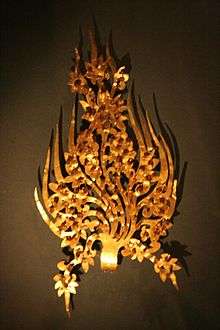 |
an ornament attached to crowns or hats |
| Hyangdae (향대) | Also called a nunmul goreum 눈물고름. A ribbon worn from the chima of a woman's dress, sometimes embroidered for upper class and sometimes with a tassel used for a handkerchief, especially in mourning. | |
| Jumeoni |  |
|
| Norigae |  |
pendants |
| Tteoljam |  |
References
- ↑ 당의 (唐衣) (in Korean). Nate / EncyKorea. Retrieved 2008-10-28.
- ↑ 당의 (唐衣) (in Korean). Nate / Britannica.
- ↑ "활옷" (in Korean). Empas / Britannica. Retrieved 2008-09-20.
- ↑ 김소현. 우전 ( khotan ) 의 복식에 관한 연구, 한국복식학회, v. 34, 169-183. 1997.
- ↑ 사규삼(四揆衫) (in Korean). National Folk Museum of Korea.
- ↑ 색동옷 (in Korean). Empas / EncyKorea. Retrieved 2008-09-29.
- ↑ 색동저고리 (in Korean). Doosan Encyclopedia. Retrieved 2008-09-29.
- ↑ "Official/Court clothing". Life in Korea.
- ↑ 원삼 (圓衫) (in Korean). Empas / EncyKorea.
- ↑ "Hanboks(Traditional Clothings)". Headgear and Accessories Worn Together with Hanbok. Korea Tourism Organization. Retrieved 2008-09-16.
- ↑ 아얌 (in Korean). Nate / EncyKorea. Retrieved 2008-09-16.
This article is issued from Wikipedia - version of the 10/18/2016. The text is available under the Creative Commons Attribution/Share Alike but additional terms may apply for the media files.